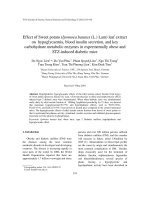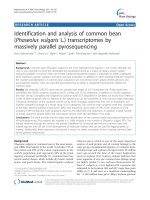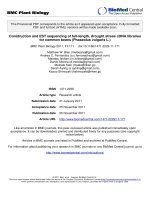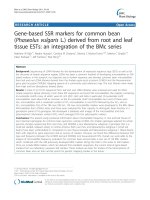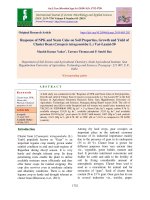Effect of fertigation and foliar application of nutrients on yield and quality of french bean (Phaseolus vulgaris L.)
Bạn đang xem bản rút gọn của tài liệu. Xem và tải ngay bản đầy đủ của tài liệu tại đây (255.11 KB, 10 trang )
Int.J.Curr.Microbiol.App.Sci (2019) 8(9): 812-821
International Journal of Current Microbiology and Applied Sciences
ISSN: 2319-7706 Volume 8 Number 09 (2019)
Journal homepage:
Original Research Article
/>
Effect of Fertigation and Foliar Application of Nutrients on Yield and
Quality of French Bean (Phaseolus vulgaris L.)
Udayakumar1*, G. Ramesh2, Shekharagouda Patil1, Y. Pampanna1 and N. Anand3
1
Department of Horticulture, College of Agriculture Raichur, University of Agricultural
Sciences, Raichur-584104, India
2
Department of Soil and Water Engineering, College of Agriculture Engineering, Raichur,
University of Agricultural Sciences,Raichur-584104, India
3
Department of Agronomy, College of Agriculture Raichur, University of Agricultural
Sciences, Raichur-584104, India
*Corresponding author
ABSTRACT
Keywords
Clusters, Crude
fibre, Fertigation,
Firmness,
Vegetable special
Article Info
Accepted:
15 August 2019
Available Online:
10 September 2019
A field experiment was conducted to evaluate the effect of fertigation and foliar
application of nutrients on yield and quality of french bean (Phaseolus vulgaris L.).The
experiment consisted of four main plots i.e., different levels of fertigation and three sub
plots i.e., foliar spray of different nutrient solutions. The experiment was conducted in split
plot design and it was replicated thrice.100 per cent RDF through fertigation and foliar
application of 0.5 per cent vegetable special recorded maximum number of pods per
clusters (7.87), more number of clusters per plant (6.73), yield per plant (171.73 g) and
yield per hectare (8.22 t).Quality parameters like higher pod length (14.44 cm), pod width
(0.9 cm) and fresh pod weight (10.33 g) was also recorded in the same treatment. Higher
shelf life, higher moisture content (89.63%), higher firmness (4.06 kg/cm2) and higher
crude fibre content(16.48%)was recorded in 100 per cent RDF through fertigation and
foliar application of 0.5 per cent vegetable special compared to other treatments. The
physiological loss in weight recorded on 2, 4, 6 and 8 days, exhibited lower values with
100 per cent RDF through fertigation and foliar application of 0.5 per cent vegetable
special.
Introduction
French bean (Phaseolus vulgaris L.) is one of
the most important leguminous vegetable. It is
also known as common bean, bush bean,
kidney bean, snap bean, haricot bean and navy
bean. It is grown for the tender green beans as
well as dry beans seeds (Rajmah). It is
originated in warm temperate region of
Central America (Mexico and Guatemala) and
Southern America, mainly the Andean
regions. There are two distinct gene pools of
french bean, one is Andean origin and other is
the Central America and Mexican origin. The
wild species Phaseolus aborigineus is
considered as the progenitor of Phaseolus
812
Int.J.Curr.Microbiol.App.Sci (2019) 8(9): 812-821
vulgaris L. French bean is grown in different
parts of the world for its mature dry seeds,
immature tender green or yellow pods (snap
bean) and for its leaves (in Africa and Asia),
which is being used as vegetable. In Northern
India, dry pods of french bean fetch higher
price compared to other pulse crops as its
vegetable preparation is considered to be one
of the most nutritious and delicious dish for
the 'Sunday special'. The dry seeds can also be
canned and exported for vegetable purpose.
Tender pods of french bean can be harvested
at about 50-60 days after sowing for vegetable
purpose.
French bean is quite nutritious and potential
source of protein, carbohydrates and minerals.
The mineral matter and crude fibre are
concentrated in seeds, while crude protein and
energy are stored in the cotyledons. It contains
about 1.7g protein, 0.8 g mineral matter, 1.8 g
fibre, 0.1 g fat 4.5 g carbohydrates, 28 mg
phosphorus, 50 mg calcium, 74 mg potassium
and 0.6 mg iron per 100 g of edible part
(Pandey and Singh, 2010).
Micronutrients such as boron, copper and zinc
also play a positive role for increasing pod as
well as seed yield in french bean.
Micronutrients are those elements that are
essential for plant growth, but are required in
smaller quantity. If these micronutrients are
not available sufficiently, plants will suffer
from physiological stress due to inefficiency
of several enzymatic systems and other related
metabolic functions (Fageria, 2009).
Fertigation has immense utility in increasing
the production of french bean. Foliar spray of
micronutrients play an important role in
increasing yields. In the past, some efforts
have been made to study the influence of
fertigation on vegetative and reproductive
parameters of french bean. However the
information on interactive effect of fertigation
and foliar sprays of nutrients is lacking. Hence
this study was taken up to assess the influence
of fertigation on growth, yield and quality of
french bean and to know the effect of foliar
sprays on growth, yield and quality of french
bean.
Materials and Methods
The experiment was conducted from
November 2018 to February 2019 in the fields
of All India Coordinated Research Project on
Plasticulture Engineering Technology, at
College of Agriculture Engineering, Raichur
University of Agricultural Sciences, Raichur.
This is located in the North Eastern dry zone
i.e., Zone –II of the region –I in Karnataka.
The location corresponds to 160 25`North
latitude and 770 33` East longitude. The
climate of the experimental location is semiarid and average annual rainfall is 722 mm.
The elevation of Raichur is 406 m above mean
sea level (MSL).
French bean variety Arka Arjun was procured
from Indian Institute of Horticulture Research,
Bengaluru. Experiment was laid out in split
plot design with twelve treatments and three
replications. The treatments consisted of main
plot treatments i.e.,M1-50% of RDF through
fertigation, M2-75% of RDF through
fertigation, M3-100% of RDF through
fertigation and M4-100% RDF as soil
application and drip irrigation and sub plot
treatments: S1- Foliar spray of humic acid
(2%), S2- Foliar spray of vegetable special
(0.5%) andS3- Foliar spray of vermiwash
(5%). Fertigation was provided at weekly
interval and foliar spray of micronutrients was
taken up at 20, 40 and 60 DAS.
The land was thoroughly ploughed and
brought to a fine tilt. Raised beds of 10m
length and 1m width were prepared. French
bean seeds were sown on the raised beds at a
spacing of 45x15 cm. Drip laterals of 4 LPH
were placed on the beds. Irrigation and
fertigation was provided as per the plan of the
experiment.
The
required
nitrogen,
813
Int.J.Curr.Microbiol.App.Sci (2019) 8(9): 812-821
phosphorous and potassium was applied to the
experimental plot through water soluble
fertilizers (WSF) i.e. 19:19:19 and 00:52:34.
Fertilizers were applied by pressure
differential method by using venturi system.
The required pressure was monitored by using
pressure gauge fitted on the supply line just
after the filter. Different growth promoting
nutrients were used through foliar application
i.e. Commercial formulation of humic acid
used in the study, was brought from market,
vegetable special was brought from Indian
Institute of Horticultural Research, Bengaluru
and vermiwash was procured from
Entomology laboratory, University of
Agricultural Sciences, Raichur. Five plants
were tagged from each plot. Observations on
growth parameters were recorded from these
tagged plants at 15, 30, 45 DAS and at
harvest. Yield parameters were recorded at
harvest.
Analysis of variance was performed following
the statistical method described by Panse and
Sukhatme (1967) and the significance
difference among the treatment means were
calculated at 5 per cent level of significance.
Results and Discussion
Yield and yield attributes
Yield attributes like number of pods per
clusters and number clusters per plant and
yield parameters like, yield plant -1 (g), yield
ha-1 (t) are presented in table 2.Fertigation
with 100 per cent RDF has recorded
maximum number of pods per clusters (7.60),
number of clusters per plant (6.47), yield
plant-1 (162.31 g) and yield ha-1 (7.42 t). Foliar
spray of 0.5 per cent vegetable special has
exhibited maximum number of pods per
clusters (7.00), more number clusters per plant
(5.73), yield plant-1 (153.15 g) and yield ha-1
(7.04 t). Among the interactions, maximum
number of pods per clusters (7.87), number of
clusters per plant (6.73), yield plant-1(171.73
g) and yield ha-1(8.22 t) was observed with
100 per cent RDF through fertigation and
foliar spray of 0.5 per cent vegetable special.
Higher number of pods per clusters, number of
clusters per plant, yield plant -1 (g), and yield
ha-1 (t) were noticed with 100 per cent RDF
through fertigation and foliar spray of
vegetable special. Higher doses of fertigation
promotes the increase in number of leaves and
leaf area which resulted in proper utilization
of solar energy leading to increase in
photosynthesis and higher dry matter
accumulation in plants. Chlorophyll is an
essential component in photosynthesis, which
is increased by higher nitrogen content in the
plants. Further phosphorous plays an
important role in transformation of sugar to
starch, transformation of ADP to ATP, vice
versa and strengthening of roots of the plant
(Patel and Patel1990). Potassium improves
overall crop growth by playing an important
role in photosynthesis and transpiration.
Higher level of nitrogen, phosphorous and
potassium at early stages of crop growth and
critical stages i.e. at flowering and pod set
might have resulted in production of more
number of pods per plant. Foliar spray of
micronutrients might have ameliorated the
physical and chemical properties of soil,
leading to adequate supply of nutrients. This
further, might have increased the production
and
accumulation
of
carbohydrates
(Basavarajeswari et al., 2008). Due to these
reasons, the interaction of 100 per cent RDF
through fertigation and foliar spray of
vegetable special have resulted in higher yield
parameters.
Quality parameters
Quality parameters like pod length, pod width,
average fresh pod weight, physiological loss
in weight, shelf life, moisture content,
firmness and fibre content are presented in
814
Int.J.Curr.Microbiol.App.Sci (2019) 8(9): 812-821
table 2, 3and 4 respectively. Longer pod
length (13.38 cm), higher pod width (0.85 cm)
and higher fresh pod weight (9.48 g) was
obtained from 100 per cent RDF through
fertigation and this was on par with 75 percent
RDF through fertigation (13.05 cm). Foliar
spray with 0.5 per cent vegetable special has
yielded longer pod length (13.70 cm), higher
pod width (0.85 cm) and higher fresh pod
weight (9.64 g).The interaction between
fertigation levels and foliar spray has shown
significant difference. Fertigation with 100 per
cent RDF and 0.5 per cent of vegetable special
has shown longer pod length (14.44 cm),
higher pod width (0.90 cm) and higher fresh
pod weight (10.33 g) compared to other
interaction effects.
Quality parameters like pod length, pod width,
and average fresh pods weight were higher
with 100 per cent RDF through fertigation.
The maximum weight of fruit, width and
length of fruit in the present study could be
attributed to enhanced supply of nutrients
through increased fertigation level in the root
vicinity of plant, and optimum nutrient
concentration in the root zone throughout the
crop growth period.
Present findings are in accordance with
Janapriya et al., (2010) who found
significantly higher fruit yield and quality
under increased fertigation level. Foliar
application of vegetable special enhanced the
quality parameters like pod length, pod width,
and average fresh pod weight in the present
study. This is due to adequate and continuous
nutrient availability through soil and foliar
nutrition promotes the supply of assimilates to
sink thus enlarging the size of the yield
structure. These could be the reasons for better
quality of pods. The findings of Uma and
Karthik (2017) have also confirmed the results
of present study. The combined effect of 100
per cent RDF through fertigation and foliar
spray of vegetable special has shown best
quality parameters like pod length, pod width,
and fresh pod weight. This might be due to
better synthesis of cytokine with optimum
supply of nitrogen and phosphorus resulting in
more number of fruits (Premsekhar and
Rajashree, 2009). Also better supply of
potassium with its split application and
supplementation of secondary and micro
nutrients might have enhanced the fruit size
(Batra et al., 2002), increased uptake of
nutrients
and
better
utilization
of
photosynthates
resulting
in
drymatter
accumulation in edible parts (Guievence and
Badem, 2000).
100 per cent RDF through fertigation has
shown lower physiological loss (51.61 %) in
weight on 8th day, higher shelf life of the pod
(6.78 days), higher moisture content (87.81
%), higher firmness of pods (3.65 kg/cm2) and
higher crude fibre content (15.90 %). Foliar
spray of 0.5 per cent vegetable special
recorded lower physiological loss in weight
(53.54 %) on 8th day, higher shelf life of the
pod (6.92 days), higher moisture content
(86.74 %), higher firmness of pods (3.69
kg/cm2) and higher crude fibre content (15.68
%). Among the interaction between fertigation
levels and foliar spray significant difference
was observed.
Fertigation with 100 per cent RDF and 0.5 per
cent of vegetable special has shown lower
physiological loss in weight (47.50 %) on 8th
day, higher shelf life of the pod (8 days),
higher moisture content (89.63 %), higher
firmness of pods (4.06 kg/cm2) and higher
crude fibre content (16.42 %)
Quality parameters like shelf life, moisture
content, firmness and fibre content were best
with 100 per cent RDF through fertigation.
This is due to higher availability of nutrients
in the vicinity of root zone which might have
helped in more absorption of NPK.
815
Int.J.Curr.Microbiol.App.Sci (2019) 8(9): 812-821
Table.1 Effect of different levels of fertigation and foliar spray of nutrients on yield and yield
attributes in french bean
Treatment
Main plot
M1-50% RDF through
fertigation
M2-75% RDF through
fertigation
M3-100% RDF through
fertigation
M4-100 RDF as soil
application
SEm±
CD at 5%
Sub plot
S1-Foliar spray of humic
acid (2%)
S2-Foliar spray of
vegetable special (0.5%)
S3-Foliar spray of
vermiwash (5%)
SEm±
CD at 5%
Interaction
M1S1
M1S2
M1S3
M2S1
M2S2
M2S3
M3S1
M3S2
M3S3
M4S1
M4S2
M4S3
SEm±
CD at 5%
Number of
pods per
clusters
Number of
pod clusters
per plant
Yield
plant-1(g)
Yield
ha-1 (t)
6.36
4.93
139.65
5.97
7.02
5.64
148.60
6.45
7.60
6.47
162.31
7.42
6.07
5.24
139.05
6.23
0.08
0.26
0.06
0.21
1.66
5.87
0.04
0.15
6.73
5.45
147.54
6.53
7.00
5.73
153.15
7.04
6.55
5.53
141.52
5.98
0.05
0.17
0.07
0.22
1.23
3.71
0.09
0.26
6.07
6.67
6.33
7.07
7.13
6.87
7.60
4.87
5.20
4.73
5.33
5.60
6.00
6.27
137.00
145.87
136.08
151.13
148.73
145.93
163.73
6.34
6.40
5.19
6.21
6.92
6.22
7.33
7.87
7.33
6.20
6.33
5.67
0.11
0.33
6.73
6.40
5.33
5.40
5.00
0.14
0.44
171.73
151.47
138.29
146.27
132.60
2.45
7.34
8.22
6.71
6.25
6.62
5.82
0.17
0.52
816
Int.J.Curr.Microbiol.App.Sci (2019) 8(9): 812-821
Table.2 Effect of different levels of fertigation and foliar spray of nutrients on quality
parameters in french bean
Treatment
Pod length
(cm)
Pod width
(cm)
Fresh pod
weight (g)
12.94
13.05
13.38
12.77
0.11
0.80
0.84
0.85
0.79
0.01
8.56
9.33
9.48
8.38
0.19
0.38
0.03
0.68
12.81
13.70
0.81
0.85
8.78
9.64
12.60
0.13
0.40
0.79
0.01
0.02
8.38
0.13
0.41
13.11
0.79
8.73
M1S2
M1S3
M2S1
M2S2
M2S3
M3S1
M3S2
M3S3
M4S1
12.63
13.09
12.83
13.42
12.90
12.88
14.44
12.82
12.42
0.84
0.77
0.82
0.87
0.81
0.82
0.90
0.82
0.81
8.73
8.20
9.53
9.90
8.56
8.93
10.33
9.17
7.93
M4S2
M4S3
SEm±
CD at 5%
14.29
11.59
0.26
0.78
0.80
0.77
0.01
0.03
9.60
7.60
0.27
0.80
Main plot
M1-50% RDF through fertigation
M2-75% RDF through fertigation
M3-100% RDF through fertigation
M4-100 RDF as soil application
SEm±
CD at 5%
Sub plot
S1-Foliar spray of humic acid (2%)
S2-Foliar spray of vegetable special
(0.5%)
S3-Foliar spray of vermiwash (5%)
SEm±
CD at 5%
Interaction
M1S1
817
Int.J.Curr.Microbiol.App.Sci (2019) 8(9): 812-821
Table.3 Effect of different levels of fertigation and foliar spray of nutrients on
physiological loss in weight in french bean
Treatment
nd
2 Day
Main plot
M1-50% RDF through
fertigation
M2-75% RDF through
fertigation
M3-100% RDF through
fertigation
M4-100 RDF as soil
application
SEm±
CD at 5%
Sub plot
S1-Foliar spray of humic
acid (2%)
S2-Foliar spray of vegetable
special (0.5%)
S3-Foliar spray of
vermiwash (5%)
SEm±
CD at 5%
Interaction
M1S1
M1S2
M1S3
M2S1
M2S2
M2S3
M3S1
M3S2
M3S3
M4S1
M4S2
M4S3
SEm±
CD at 5%
Physiological loss in weight (%)
4th Day
6th Day
8th Day
10.39
32.11
46.89
56.78
11.00
33.67
45.33
53.78
10.56
32.33
44.44
51.61
11.11
37.11
50.89
58.67
0.90
NS
0.94
3.33
0.76
2.67
1.20
4.24
10.50
33.17
45.92
55.08
10.75
32.75
45.00
53.54
11.04
35.50
49.75
57.00
0.50
NS
0.73
2.21
0.59
1.78
0.91
2.74
9.67
11.67
9.83
10.33
10.33
12.33
10.83
31.67
32.67
32.00
33.33
33.33
34.33
33.00
46.00
47.33
47.33
45.00
42.33
48.67
44.67
55.00
58.67
56.67
51.33
53.00
57.00
55.33
9.83
11.00
11.17
11.17
11.00
1.53
NS
30.00
34.00
34.67
35.00
41.67
1.63
NS
41.33
47.33
48.00
49.00
55.67
1.18
3.53
47.50
52.00
58.67
55.00
62.33
1.81
5.43
818
Int.J.Curr.Microbiol.App.Sci (2019) 8(9): 812-821
Table.4 Effect of different levels of fertigation and foliar spray of nutrients on quality
parameters in french bean
Treatment
Shelf life
(Days)
Moisture
content (%)
Firmness
(kg/cm2 )
Crude fibre
content (%)
6.44
84.46
3.35
15.24
6.67
86.08
3.47
15.21
6.78
87.81
3.65
15.90
6.00
82.01
3.36
15.25
0.14
0.48
0.79
2.72
0.06
0.22
0.03
0.09
6.33
84.63
3.37
15.13
6.92
86.74
3.69
15.68
6.17
83.90
3.32
15.40
0.09
0.42
0.02
0.02
0.27
1.26
0.07
0.06
M2S2
M2S3
M3S1
6.33
6.67
6.33
6.67
7.00
6.33
6.33
84.23
86.00
83.13
84.90
86.83
86.50
86.57
3.26
3.48
3.32
3.38
3.71
3.30
3.53
13.73
15.64
16.35
14.24
14.93
16.46
16.46
M3S2
M3S3
M4S1
M4S2
M4S3
SEm±
CD at 5%
8.00
6.00
6.00
6.00
6.00
0.18
0.54
89.63
87.23
82.80
84.50
78.72
0.84
2.52
4.06
3.37
3.29
3.50
3.28
0.05
0.14
16.42
14.83
16.07
15.73
13.94
0.04
0.13
Main plot
M1-50% RDF through
fertigation
M2-75% RDF through
fertigation
M3-100% RDF through
fertigation
M4-100 RDF as soil
application
SEm±
CD at 5%
Sub plot
S1-Foliar spray of humic
acid (2%)
S2-Foliar spray of vegetable
special (0.5%)
S3-Foliar spray of
vermiwash (5%)
SEm±
CD at 5%
Interaction
M1S1
M1S2
M1S3
M2S1
819
Int.J.Curr.Microbiol.App.Sci (2019) 8(9): 812-821
Nitrogen, phosphorus and potassium are most
indispensable for growth and development of
the plant, as these are the basic fundamental
constituents of all living matter. Thus, they
increase the carbohydrates, and proteins in the
reproductive parts as well. This might have
helped in higher dry matter accumulation in
pods of french beans. Hence, the pods have
shown higher moisture content, fibre content,
firmness, good shelf life and less
physiological loss in weight. Foliar
application of vegetable special enhanced the
post-harvest parameters like shelf life,
moisture content, firmness and fibre content.
At the same time physiological loss in weight
was lower. The increase in dry matter
production in plants due to foliar spray of
vegetable special might have resulted in
greater accumulation of photosynthates by
vegetative parts and its subsequent
translocation to the sink. This ultimately
improved the post-harvest parameters in
french bean. Similar results were given by
Pandita et al., (1976) and Singh et al.,
(2003).The combined effect of 100 per cent
RDF through fertigation and foliar spray of
0.5 per cent vegetable special, exhibited
higher values for moisture content, firmness,
fibre content, and lower values for
physiological loss in weight. This could be
due to the absorption of readily available
micronutrients through the foliage of the
plant, as a result of foliar spray. The
favourable environment created due to the
conjunctive availability of macronutrients and
micronutrients increased the accumulation of
carbohydrates in the sink, thus resulting in
better quality of french beans.
of 0.5 per cent vegetable special resulted in
higher yield and good quality pods. Combined
effect of 100 per cent RDF through fertigation
and foliar spray of 0.5 per cent vegetable
special also showed improved pod yield and
quality of french bean pods, compared to
other interactions. From the present research,
we can concluded that 100 per cent RDF
through fertigation and 0.5 per cent foliar
spray of vegetable special is suitable for the
cultivation of french bean as it provides
higher yields and good quality pods.
Acknowledgement
The authors acknowledge All India
Coordinated Research Project on Plasticulture
Engineering Technology, Raichur for
extending the support during the conduct of
present research.
References
Basavarajeswari, C, P., Hosamni R, M.,
Ajjappalavara, P, S., Naik, B, H.,
Smitha, R, P., 2008. Effect of foliar
application of micronutrients on
growth, yield components of Tomato
(Lycopersicon
esculentum
Mill):
Karnataka J. Agri. Sci. 21(3):428-430.
Batra, V. K., Singh, B. and Singh, V., 2002.
Response of brinjal to foliar feeding of
water soluble fertilizers. International
conference on vegetables, 11-14 at
Bengaluru (Karnataka) India.
Fageria, N. K., 2009. The use of nutrients in
crop plants, CRS Press, Taylor and
Francis group.
Guievence, I., Badem. H., 2000. Effect of
foliar application of different sources
and levels of nitrogen on growth and
yield of tomato. Indian J. Agric. Sci.,
72(2): 104-105.
Janapriya,
S.,
Palanisamy,
D.
and
Ranghaswami, M. V., 2010. Soilless
media and fertigation for naturally
From the investigation, it can be concluded
that the application of 100% RDF through
fertigation exhibited higher pod yield and
good quality pods. Thus, drip fertigation helps
to improve pod yield and pod quality of
french bean, compared to conventional
method of fertilizer application. Foliar spray
820
Int.J.Curr.Microbiol.App.Sci (2019) 8(9): 812-821
ventilated polyhouse production of
cucumber (Cucumis sativus L.) cv
Green Long. Int. J. Agric. Envi
Biotech., 3(2): 199-205.
Pandey, A. K. and Singh, M., 2010. Legume
Vegetables. Ashim printline, Delhi.
pp. 101.
Pandita, M. L., Arora, S. K. and Singh, K.,
1976. Effect of plant growth
regulators on fruit set, early and total
yield of tomato variety HS-101
(Lycopersicon
esculentum
Mill.)
during summer season. Haryana J.
Hort. Sci., 8(3 and 4): 112-116.
PanseV. G. and Sukhatme,P. V. 1967.
“Statistical Methods for Agricultural
Workers,” 2nd Edition, Indian Council
of Agricultural Research, New Delhi,
pp.381.
Patel, J. J. and Patel, A. T., 1990. Effect of
nitrogen and phosphorus levels on
growth and yield of onion (Allium
cepa L.) cultivar Pusa Red. Gujarat
Agric. Uni. Res. J., 15(2): 1-5
Premsekhar, M. and Rajashree, V., 2009.
Performance of hybrid tomato as
influenced by foliar feeding of watersoluble fertilizers. Am. Eurasian J.
Sustain. Agric., 3(1): 33-36.
Singh, M., Batra, V. K., Bhatia, A. K., Singh,
V. and Arora, S. K. 2003. Response of
foliar application of micronutrients on
tomato variety “Hisar Arun”. Veg.
Sci., 30(2): 182-184.
Uma, M. M., and Karthik, A., 2017. Effect of
foliar nutrition on growth, yield
attributes and seed yield of pulse
crops. Adv. Crop Sci. Tech., 5: 3
How to cite this article:
Udayakumar, G. Ramesh, Shekharagouda Patil, Y. Pampanna and Anand, N. 2019. Effect of
Fertigation and Foliar Application of Nutrients on Yield and Quality of French Bean
(Phaseolus vulgaris L.). Int.J.Curr.Microbiol.App.Sci. 8(09): 812-821.
doi: />
821
